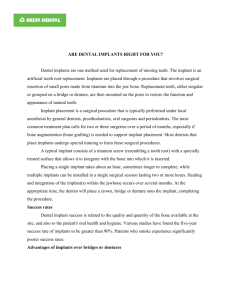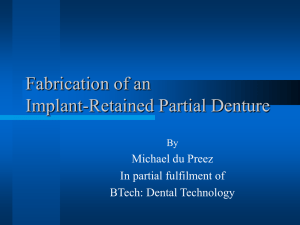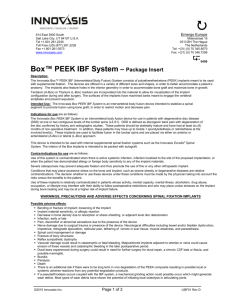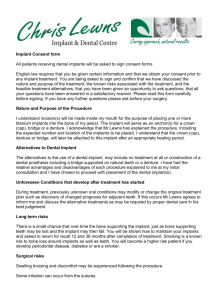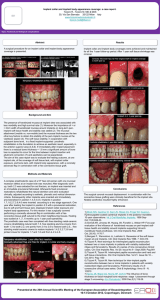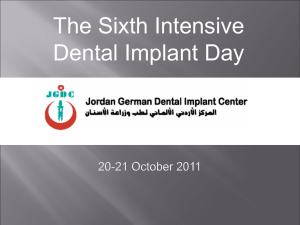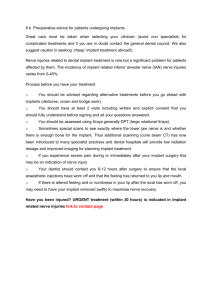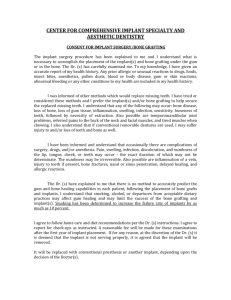614 East 3900 South Emergo Europe Salt Lake City, UT 84107
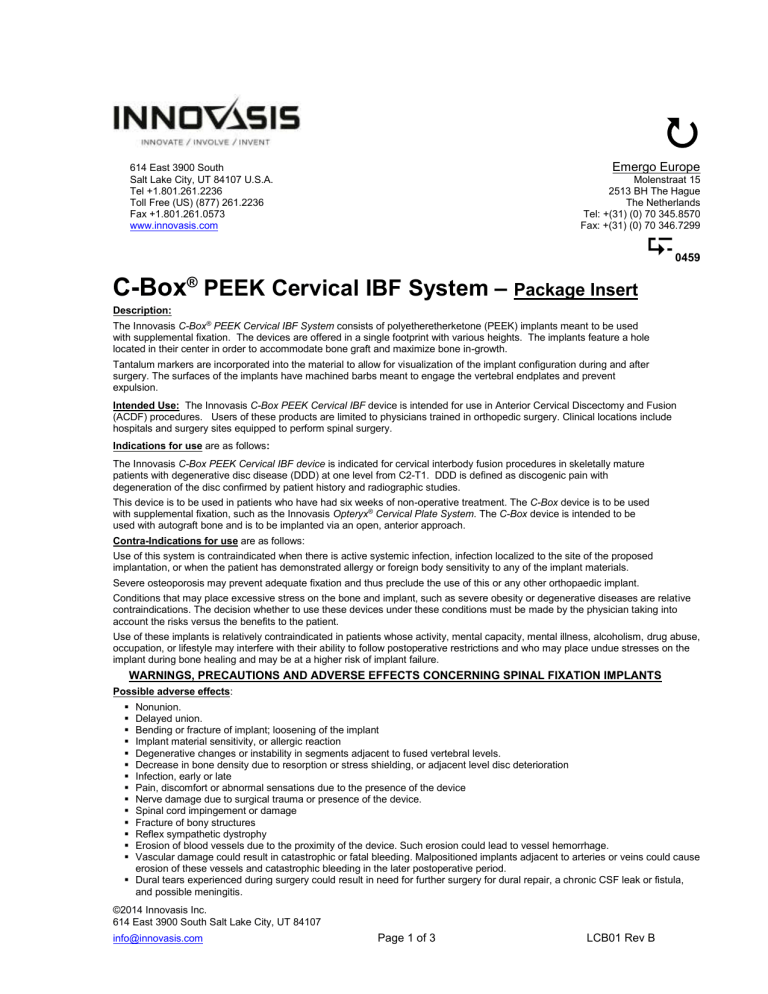
614 East 3900 South
Salt Lake City, UT 84107 U.S.A.
Tel +1.801.261.2236
Toll Free (US) (877) 261.2236
Fax +1.801.261.0573 www.innovasis.com
Emergo Europe
Molenstraat 15
2513 BH The Hague
The Netherlands
Tel: +(31) (0) 70 345.8570
Fax: +(31) (0) 70 346.7299
0459
C-Box
®
PEEK Cervical IBF System
–
Package Insert
Description:
The Innovasis C-Box
®
PEEK Cervical IBF System consists of polyetheretherketone (PEEK) implants meant to be used with supplemental fixation. The devices are offered in a single footprint with various heights. The implants feature a hole located in their center in order to accommodate bone graft and maximize bone in-growth.
Tantalum markers are incorporated into the material to allow for visualization of the implant configuration during and after surgery. The surfaces of the implants have machined barbs meant to engage the vertebral endplates and prevent expulsion.
Intended Use: The Innovasis C-Box PEEK Cervical IBF device is intended for use in Anterior Cervical Discectomy and Fusion
(ACDF) procedures. Users of these products are limited to physicians trained in orthopedic surgery. Clinical locations include hospitals and surgery sites equipped to perform spinal surgery.
Indications for use are as follows :
The Innovasis C-Box PEEK Cervical IBF device is indicated for cervical interbody fusion procedures in skeletally mature patients with degenerative disc disease (DDD) at one level from C2-T1. DDD is defined as discogenic pain with degeneration of the disc confirmed by patient history and radiographic studies.
This device is to be used in patients who have had six weeks of non-operative treatment. The C-Box device is to be used with supplemental fixation, such as the Innovasis Opteryx
®
Cervical Plate System . The C-Box device is intended to be used with autograft bone and is to be implanted via an open, anterior approach.
Contra-Indications for use are as follows:
Use of this system is contraindicated when there is active systemic infection, infection localized to the site of the proposed implantation, or when the patient has demonstrated allergy or foreign body sensitivity to any of the implant materials.
Severe osteoporosis may prevent adequate fixation and thus preclude the use of this or any other orthopaedic implant.
Conditions that may place excessive stress on the bone and implant, such as severe obesity or degenerative diseases are relative contraindications. The decision whether to use these devices under these conditions must be made by the physician taking into account the risks versus the benefits to the patient.
Use of these implants is relatively contraindicated in patients whose activity, mental capacity, mental illness, alcoholism, drug abuse, occupation, or lifestyle may interfere with their ability to follow postoperative restrictions and who may place undue stresses on the implant during bone healing and may be at a higher risk of implant failure.
WARNINGS, PRECAUTIONS AND ADVERSE EFFECTS CONCERNING SPINAL FIXATION IMPLANTS
Possible adverse effects :
Nonunion.
Delayed union.
Bending or fracture of implant; loosening of the implant
Implant material sensitivity, or allergic reaction
Degenerative changes or instability in segments adjacent to fused vertebral levels.
Decrease in bone density due to resorption or stress shielding, or adjacent level disc deterioration
Infection, early or late
Pain, discomfort or abnormal sensations due to the presence of the device
Nerve damage due to surgical trauma or presence of the device.
Spinal cord impingement or damage
Fracture of bony structures
Reflex sympathetic dystrophy
Erosion of blood vessels due to the proximity of the device. Such erosion could lead to vessel hemorrhage.
Vascular damage could result in catastrophic or fatal bleeding. Malpositioned implants adjacent to arteries or veins could cause erosion of these vessels and catastrophic bleeding in the later postoperative period.
Dural tears experienced during surgery could result in need for further surgery for dural repair, a chronic CSF leak or fistula, and possible meningitis.
©2014 Innovasis Inc.
614 East 3900 South Salt Lake City, UT 84107 info@innovasis.com
Page 1 of 3 LCB01 Rev B
Bursitis
Paralysis
Death
If a pseudarthrodesis occurs coupled with the IBF system, a mechanical grinding action could possibly occur which might generate wear debris. Wear debris has the potential of initiating local osteolysis in articulating joints.
There is an additional risk if there were to be long term in vivo degradation of the PEEK composite, of possible local or systemic adverse reactions from any potential degradation products.
WARNING
1. Explanted surgical implants must never be reused. This product is single use only. Even though a device appears undamaged, it may have defects and internal stress patterns which may lead to premature failure.
2. Correct handling of the implants is extremely important. Surface damage or alterations may produce defects in surface finish and may create internal stresses that could facilitate the eventual breakage of the implant.
PRECAUTIONS
General
The implantation of intervertebral body fusion devices should be performed only by experienced spinal surgeons with specific training in the use of cervical IBF systems because this is a technically demanding procedure presenting a risk of serious injury to the patient. The physician/surgeon should thoroughly review the C-Box Surgical Technique Guide before surgery. This guide is available on line at www.innovasis.com
. A paper copy is available on request (contact information at the top of this document.)
Proper implant selection and patient compliance with postoperative precautions will greatly affect the surgical outcome.
Do not use components of this system with components from another manufacturer.
Patients who smoke have been shown to have an increased level of non-unions. Therefore, these patients should be advised of this fact and warned of the potential consequences.
Preoperative
The single-use implants are provided non-sterile. Instruments must be cleaned and sterilized before use.
The surgeon must confirm that all necessary implants and instruments are on hand for the planned surgical construct. The implant components should be handled and stored carefully and protected from any damage including corrosive environments. They should be carefully unpacked and examined for damage.
Intraoperative
Extreme caution must be taken around the spinal cord and nerve roots.
Breakage, slippage or mishandling of the instruments or implant components, such as sharp edges, may cause injury to the patient or operative personnel.
Postoperative
The patient must be adequately instructed as to the risks and limitations of the implant as well as postoperative care and rehabilitation. The patient’s ability and willingness to follow instructions are some of the most critical aspects of successful bone healing.
The patient should be instructed in the limitations of physical activities, which would place excessive stresses on the implant or cause delay of the healing process. The patient should be instructed to limit and restrict twisting and sudden jerking motions and any type of sports participation until the bone is healed.
The patient should understand that an implant is not as strong as normal healthy bone and could loosen, bend and/or break if excessive demands are placed on it, especially in the absence of complete bone healing. Implants displaced or damaged by improper activities may experience migration of the devices and damage to nerves or blood vessels.
The patient must be adequately instructed/informed that fusion of vertebrae may result in stress on adjacent levels.
The C-Box PEEK Cervical IBF System has not been evaluated for safety and compatibility in the MR environment. The C-Box
PEEK Cervical IBF System has not been tested for heating or migration in the MR environment.
POSTOPERATIVE MOBILIZATION
Careful patient handling for the first two to four months following the operation is very important while the fusion mass matures and becomes able to share load with the implant. Instructions to the patient to reduce stress on the implants are an equally important part of the attempt to avoid the occurrence of clinical problems that may accompany fixation failure.
Postoperative external immobilization (such as bracing) is recommended, at the surgeon’s discretion.
Once the fusion mass has healed, the supplemental fixation device may be removed to prevent stress-shielding of the fused bone. As in all patient care issues, this is left to the discretion of the operating surgeon.
CLEANING AND STERILIZATION
Implants are for single use only. Implants are not sterile when shipped from Innovasis. All instruments must be disassembled and cleaned using neutral cleaners after use and before sterilization and introduction into a sterile surgical field or (if applicable) return of
©2014 Innovasis Inc.
614 East 3900 South Salt Lake City, UT 84107 info@innovasis.com
Page 2 of 3 LCB01 Rev B
the product to INNOVASIS. Cleaning and disinfecting of instruments can be performed with aldehyde-free solvents at higher temperatures. Cleaning and decontamination must include the use of neutral cleaners followed by deionized water rinse.
Note: certain cleaning solutions such as those containing formalin, gluteraldehyde, bleach and/or other alkaline cleaners may damage some devices, particularly instruments; these solutions should NOT be used. Also, many instruments require disassembly before cleaning.
Detailed cleaning recommendations are in the Innovasis Surgical Instrument Cleaning , Sterilization and Reuse instruction
LG01.
All products should be treated with care. Improper use or handling may lead to damage and/or possible improper functioning of the device.
STERILIZATION
Implants and instruments are supplied clean but NOT STERILE. They must be sterilized by the hospital prior to use. FDA cleared wraps are recommended for use with the sterilization tray. Remove all packaging materials prior to sterilization. Only sterile products should be placed in the operative field. For a 10 -6 Sterility Assurance Level, the C-Box Peek Cervical IBF System implants and instruments (full set in tray) are recommended to be steam sterilized by the hospital using one of the two sets of process parameters listed below.
METHOD CYCLE TEMPERATURE EXPOSURE TIME DRY TIME
Steam
Steam
Pre-Vacuum (Wrapped)
Gravity Displacement (Wrapped)
270 °F (132°C)
270°F (132°C)
4 Minutes
15 Minutes
NOTE: Because the many variables involved in sterilization, each medical facility should calibrate and verify the sterilization process (e.g. temperatures, times) used for equipment.
CAUTION: Federal Law (U.S.A) restricts these devices to sale by or on order of a physician.
45 Minutes
45 Minutes
©2014 Innovasis Inc.
614 East 3900 South Salt Lake City, UT 84107 info@innovasis.com
Page 3 of 3 LCB01 Rev B

